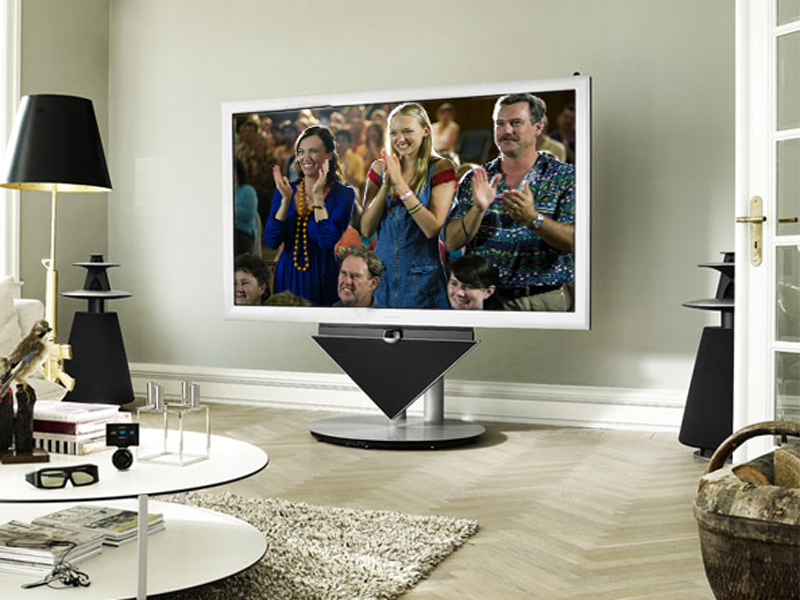TechRadar Verdict
Pros
- +
Contrast
- +
Colour
- +
Easy to use
- +
3D pictures
- +
Robotic camera
- +
Good with all sources
Cons
- -
High cost
- -
Mono speaker
- -
No Freeview HD
- -
Beo6 remote costs £600
Why you can trust TechRadar
It's no surprise that Bang & Olufsen's first 3D TV also happens to be one of the most expensive sets ever produced.
More likely to be found on a yacht or luxury custom installation than the average living room, the BeoVision 4-85 boasts an 85-inch plasma screen, a host of features and a price that would make Croesus himself blush.
The display is the same as that behind Panasonic's TH-85VX200, so its pedigree isn't in doubt. Amazingly, though, the 4-85 is about to become the smallest TV in the BeoVision range, with the non-3D 65-inch version being phased out and a whopping 103-inch version (BeoVision 4-103) waiting in the wings.
The latter, with its motorised stand, will cost you – deep breath – close to £100,000. If you decide to wall-mount it, the price comes down to a trifling £82,000.
For now, this 85-incher is the only plasma sold by Bang & Olufsen, the rest of its range being mostly LED-backlit LCD TVs that are as delectably designed as they are expensive. At the entry level – if such a thing exists within B&O's money-no-object ethos – is the BeoVision 8-40.
A snip at £4,500, this 40-inch TV has a full HD resolution, 200Hz and a surround sound decoder, plus a soundbar-style speaker system.
Next up is the BeoVision 10 range, all of which have a curiously square aspect, thanks to the three-way speakers slung under the displays.
The variations comprise the 32-inch BeoVision 10-32 (£4,500), 40-inch BeoVision 10-40 (£7,000) and 46-inch BeoVision 10-46 (£8,500), with only the smaller version unable to cope with surround sound. All have 200Hz, full HD and an anti-glare screen covering that's also seen on this 85-incher (it works, too; switch-off the TV and reflections are only faint).
Finally, aside from this 3D monster, is the BeoVision 7 range, which comprises the BeoVision 7-40 (£11,000) and BeoVision 10-55 (£16,000). The smaller is LCD, the larger LED-lit, yet both have perhaps the greatest feature of all; built-in Blu-ray. It's not 3D, sadly (it soon will be), but is designed quite brilliantly. Press Eject and a Blu-ray disc (or DVD) silently slips out, supported by a slim column.
All Bang & Olufsen TVs – and especially the BeoVision 4-85 – are programmable. An engineer asks you exactly what other products you have – say, a Sky+HD box and a Sony Blu-ray player – and the controls for those are integrated into the remote control.
However, if you change your components around, an engineer does have to pay another visit to reconfigure the remote.
It's the kind of personal service you'd expect if paying this much cash, though the charges keep on coming. You can't just barge into a Bang & Olufsen store and purchase the BeoVision 4-85, though. A site survey must be carried out first, largely to make sure the TV will fit through your doorway, and be supported by your walls or floor.
The site visit costs £300, though it's refundable if you decide to buy a BeoVision 4-85. The final charge is for delivery, which, as you can imagine, requires some pretty specialist lifting equipment; say goodbye to between £4,000 and £10,000. The main reason for that is the BeoVision 4-85's clever floor stand that weighs a whopping 500kg.
Whereas most TV stands rotate and wriggle, this one elevates. It's largely a show-off feature and not aimed specifically at improving the viewing angle or picture, but it's still addictive; switch the TV on from the remote and it rises to attention, revealing the BeoLab 10 speaker (also part of that 500kg bulk) as it does so.
This feature can be customised to exact proportions, with the TV leaning back or turning slightly. Does a TV need to have one position when switched-off, and another when turned on? No, not really – though arguably that's more important with an 85-inch TV, which is likely to become the focal point of any room, however large.
When it's switched-off, the BeoVision 4 retracts down to the floor – just an inch or two above, in fact – and from down there it doesn't dominate quite so much.
No sooner has the TV lifted into position than the TV comes to life – no coincidence – in typical B&O style; a pair of digital curtains part on the screen to reveal a live TV channel.
Jamie is a freelance tech, travel and space journalist based in the UK. He’s been writing regularly for Techradar since it was launched in 2008 and also writes regularly for Forbes, The Telegraph, the South China Morning Post, Sky & Telescope and the Sky At Night magazine as well as other Future titles T3, Digital Camera World, All About Space and Space.com. He also edits two of his own websites, TravGear.com and WhenIsTheNextEclipse.com that reflect his obsession with travel gear and solar eclipse travel. He is the author of A Stargazing Program For Beginners (Springer, 2015),

